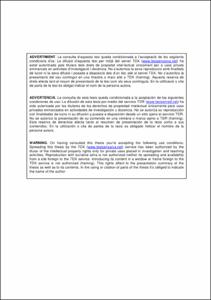Mostra el registre d'ítem simple
Multifield-based modeling of material failure in high performance reinforced cementitious composites
| dc.contributor | Oliver Olivella, Xavier |
| dc.contributor | Huespe, A. |
| dc.contributor.author | Mora, D. F. (Diego Fernando) |
| dc.contributor.other | Universitat Politècnica de Catalunya. Departament de Resistència de Materials i Estructures a l'Enginyeria |
| dc.date.accessioned | 2013-07-09T11:16:12Z |
| dc.date.available | 2013-07-09T11:16:12Z |
| dc.date.issued | 2013-04-26 |
| dc.identifier.citation | Mora, D. F. (Diego Fernando). Multifield-based modeling of material failure in high performance reinforced cementitious composites. Tesi doctoral, UPC, Departament de Resistència de Materials i Estructures a l'Enginyeria, 2013. DOI 10.5821/dissertation-2117-94930. |
| dc.identifier.uri | http://hdl.handle.net/2117/94930 |
| dc.description.abstract | Cementitious materials such as mortar or concrete are brittle and have an inherent weakness in resisting tensile stresses. The addition of discontinuous fibers to such matrices leads to a dramatic improvement in their toughness and remedies their deficiencies. It is generally agreed that the fibers contribute primarily to the post-cracking response of the composite by bridging the cracks and providing resistance to crack opening. On the other hand, the multifield theory is a mathematical tool able to describe materials which contain a complex substructure. This substructure is endowed with its own properties and it interacts with the macrostructure and influences drastically its behavior. Under this mathematical framework, materials such as cement composites can be seen as a continuum with a microstructure. Therefore, the whole continuum damage mechanics theory, incorporating a new microstructure, is still applicable. A formulation, initially based on the theory of continua with microstructure Capriz, has been developed to model the mechanical behavior of the high perfor-mance fiber cement composites with arbitrarily oriented fibers. This formulation approaches a continuum with microstructure, in which the microstructure takes into account the fiber-matrix interface bond/slip processes, which have been recognized for several authors as the principal mechanism increasing the ductility of the quasi-brittle cement response. In fact, the interfaces between the fiber and the matrix become a limiting factor in improving mechanical properties such as the tensile strength. Particularly, in short fiber composites is desired to have a strong interface to transfer effectively load from the matrix to the fiber. However, a strong interface will make difficult to relieve fiber stress concentration in front of the approaching crack. According to Naaman, in order to develop a better mechanical bond between the fiber and the matrix, the fiber should be modified along its length by roughening its surface or by inducing mechanical defor-mations. Thus, the premise of the model is to take into account this process considering a micro field that represents the slipping fiber-cement displacement. The conjugate generalized stress to the gradient of this micro-field verifies a balance equation and has a physical meaning. This contribution includes the computational modeling aspects of the high fiber rein-forced cement composites (HFRCC) model. To simulate the composite material, a finite element discretization is used to solve the set of equations given by the multifield approach for this particular case. A two field discretization: the standard macroscopic and the micro-scopic displacements, is proposed through a mixed finite element methodology. Furthermore, a splitting procedure for uncoupling both fields is proposed, which provides a more convenient numerical treatment of the discrete equation system. The initiation of failure in HPFRCC at the constitutive level identified as the onset of strain localization depends on the mechanical properties of the all compounds and not only on the matrix ones. As localization criteria is considered the bifurcation analysis in combination with the localized strain injection technique presented by Oliver et al. It consists of injecting a specific localization mode during the localization stage, via mixed finite element formulations, to the path of elements that are going to capture the cracks, and, in this way, the spurious mesh orientation dependence is removed. Model validation was performed using a selected set of experiments that proves the via-bility of this approach. The numerical examples of the proposed formulation illustrated two relevant aspects, namely: 1) the role of the bonding mechanism in the strain hardening be-havior after cracking in the HPFRCC and 2) the role that plays the finite element formulation in capturing the displacement localization in the localization stage. |
| dc.format.extent | 171 p. |
| dc.language.iso | eng |
| dc.publisher | Universitat Politècnica de Catalunya |
| dc.rights | ADVERTIMENT. L'accés als continguts d'aquesta tesi doctoral i la seva utilització ha de respectar els drets de la persona autora. Pot ser utilitzada per a consulta o estudi personal, així com en activitats o materials d'investigació i docència en els termes establerts a l'art. 32 del Text Refós de la Llei de Propietat Intel·lectual (RDL 1/1996). Per altres utilitzacions es requereix l'autorització prèvia i expressa de la persona autora. En qualsevol cas, en la utilització dels seus continguts caldrà indicar de forma clara el nom i cognoms de la persona autora i el títol de la tesi doctoral. No s'autoritza la seva reproducció o altres formes d'explotació efectuades amb finalitats de lucre ni la seva comunicació pública des d'un lloc aliè al servei TDX. Tampoc s'autoritza la presentació del seu contingut en una finestra o marc aliè a TDX (framing). Aquesta reserva de drets afecta tant als continguts de la tesi com als seus resums i índexs. |
| dc.source | TDX (Tesis Doctorals en Xarxa) |
| dc.subject | Àrees temàtiques de la UPC::Enginyeria dels materials |
| dc.title | Multifield-based modeling of material failure in high performance reinforced cementitious composites |
| dc.type | Doctoral thesis |
| dc.subject.lemac | Mecànica aplicada lemac |
| dc.subject.lemac | Deformacions (Mecànica) |
| dc.subject.lemac | Disseny d'estructures |
| dc.subject.lemac | Esforç i tensió |
| dc.identifier.doi | 10.5821/dissertation-2117-94930 |
| dc.identifier.dl | B. 20549-2013 |
| dc.rights.access | Open Access |
| dc.description.version | Postprint (published version) |
| dc.identifier.tdx | http://hdl.handle.net/10803/117529 |


